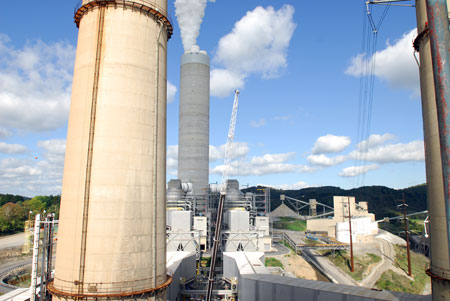Allegheny Energy's Effort Fails to Satisfy All
Pittsburgh Tribune-Review
14 October 2009
By Rick Stouffer

Hatfield's Ferry plant - Joe
Appel/Tribune-Review
Hatfield's Ferry Power Station at a glance:
- What: Three-unit power plant generating 1,710 megawatts of
electricity.
- Where: On the Monongahela River in Cumberland Township,
Greene County, on the Fayette County border and across the river from
Masontown.
- Opened: First unit went online in 1969
- Coal burned: About 4 million tons annually, including about
1 million tons of low-sulphur Powder River Basin coal, transported from
the Southeast Montana-Northeast Wyoming region.
- Employees: About 160
- Water used: About 25 million gallons per day from the
Monongahela River
- Emissions control equipment cost since 2006: $898.8 million
Since 2006, Allegheny Energy Inc. has spent nearly $900 million on
installation of emissions-control equipment at a single power plant —
Hatfield's Ferry in Cumberland, Greene County.
As installation of equipment known as scrubbers wraps up at the plant,
environmental groups and the federal government are saying the
Greensburg-based power company has made progress, but more challenges
and costs are ahead.
The scrubbers will remove 150,000 tons of acid rain-causing sulphur
dioxide from the three-unit, 1,710 megawatt power plant, or about 95
percent of the pollutant it makes annually. In addition, the scrubbers
will cleanse about 840 pounds of mercury, or 40 percent to 70 percent
of the plant's annual discharge.
Allegheny Energy is one of many power plant owners installing
scrubbers. The U.S. Energy Information Administration estimates that
scrubber additions nationwide are planned for power plants producing
139 million megawatts of electricity at an estimated cost of more than
$30 billion. One megawatt of generating capacity powers about 800 homes.
Even so, environmentalists are concerned that the new scrubbers at
Hatfield's Ferry are merely transferring emissions from the air to the
1.7 million gallons of water returned daily by the plant to the
Monongahela River. About 500,000 gallons of the water is
scrubbers-related.
"Our concern now is the permit that the state granted to treat
wastewater at Hatfield's Ferry. They are discharging some heavy metals
and other pollutants that previously would go up the stacks," said Phil
Coleman, a board member with the Washington, Pa.-based environmental
group Center for Coalfield Justice.
This year, Coleman was party to an appeal filed by environmental groups
Citizens Coal Council of Washington County and the Environmental
Integrity Project, Washington, D.C., with the state Environmental
Hearing Board. The appeal contests a wastewater discharge permit issued
by the state Department of Environmental Protection that allows
scrubber-related water to go back into the river.
The groups claims the permit — which is being contested by Allegheny
Energy as being too strict — is too lenient because it allows the
company to discharge wastewater into the river with alleged high levels
of pollutants.
Allegheny Energy disagrees, pointing to a new $25 million wastewater
treatment system at the plant that "removes suspended solids and heavy
metals from the scrubber stream" and meets limits under federal rules,
spokesman Doug Colafella said.
The state Department of Environmental Protection issued the discharge
permit in December. The agency included more restrictive limits on
solids and sulfate well after Allegheny Energy began construction,
Colafella said.
The wastewater retreatment system installed at the plant along with the
scrubber project cannot meet the limits in the state permit, Colafella
said.
Last month, the Environmental Protection Agency announced plans to
revise for the first time since 1982 existing wastewater discharge
standards for coal-fired power plants. The EPA this year completed a
multi-year study of power plant wastewater discharge and concluded the
existing 27-year-old rules haven't kept pace with changes in the power
industry.
Utilities like Allegheny Energy that generate power at coal-fired
plants will face more emission-control challenges.
Late last month, the EPA proposed lowering limits on greenhouse gas
emissions, including carbon dioxide under the auspices of the national
Clean Air Act and amendments, laws dating back decades.
The major emissions control expense that all coal-fired power plant
owners are grappling with is handling carbon dioxide. Hatfield's Ferry
in 2008 released about 44 million tons of carbon dioxide into the air
from burning coal.
Large industrial facilities, including coal-fired power plants,
factories and refineries that emit at least 25,000 tons of greenhouse
gases annually would be required to obtain permits covering the
emissions.
"This is a common sense rule that is carefully tailored to apply to
only the largest sources — those from sectors responsible for nearly 70
percent of U.S. greenhouse gas emissions sources," EPA Administrator
Lisa P. Jackson said in announcing the proposed rule.
Environmentalists acknowledge it's very early regarding the proposed
EPA regulations.
"The EPA rule means that Hatfield's Ferry would have to meet 'best
available technology' criteria for carbon dioxide if the plant was
physically modified in a way that increased emissions," said Eric
Schaeffer, executive director of the Environmental Integrity Project.
Schaeffer said the EPA is still years away from determining what the
best available technology will be. The most widely discussed method for
dealing with carbon dioxide is known as carbon capture and
sequestration, or burying carbon emissions, which is extremely
expensive.
"To liquify the carbon dioxide and pump it into the ground is very
costly. Plus it would take 15 percent of a plant's power output to do
so," Scaccia said.
About the writer
Rick Stouffer can be reached via e-mail or at 412-320-7853.
